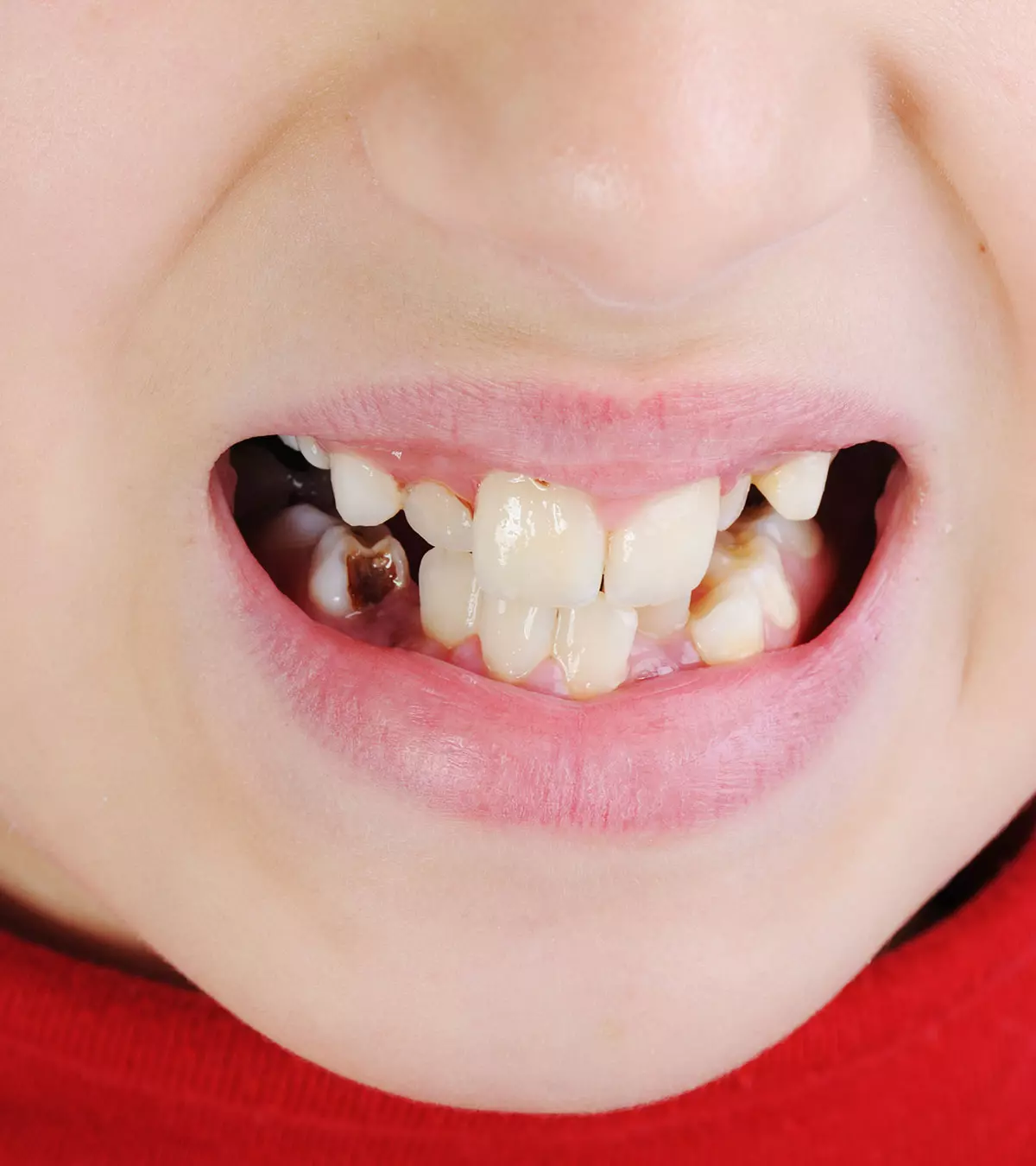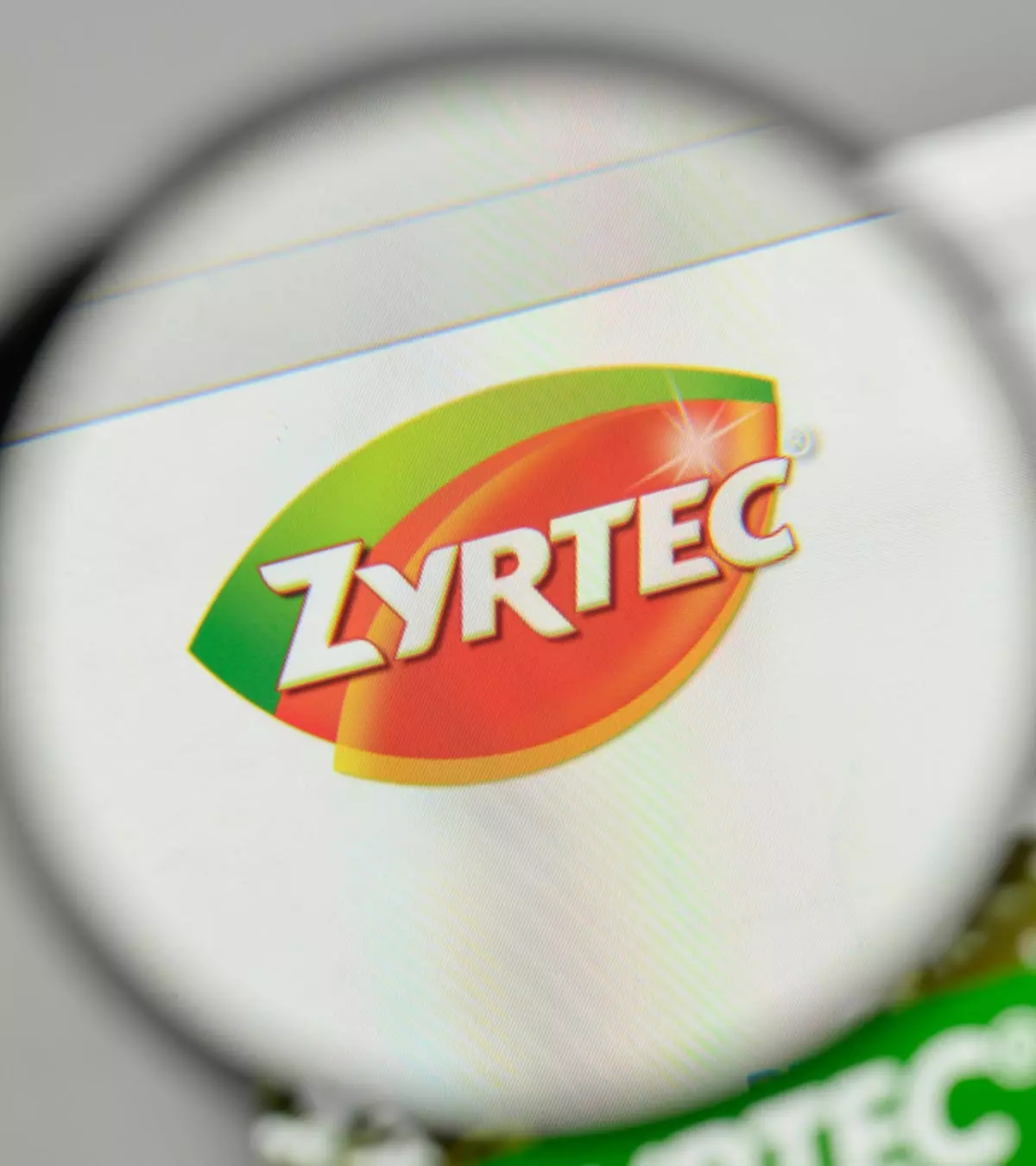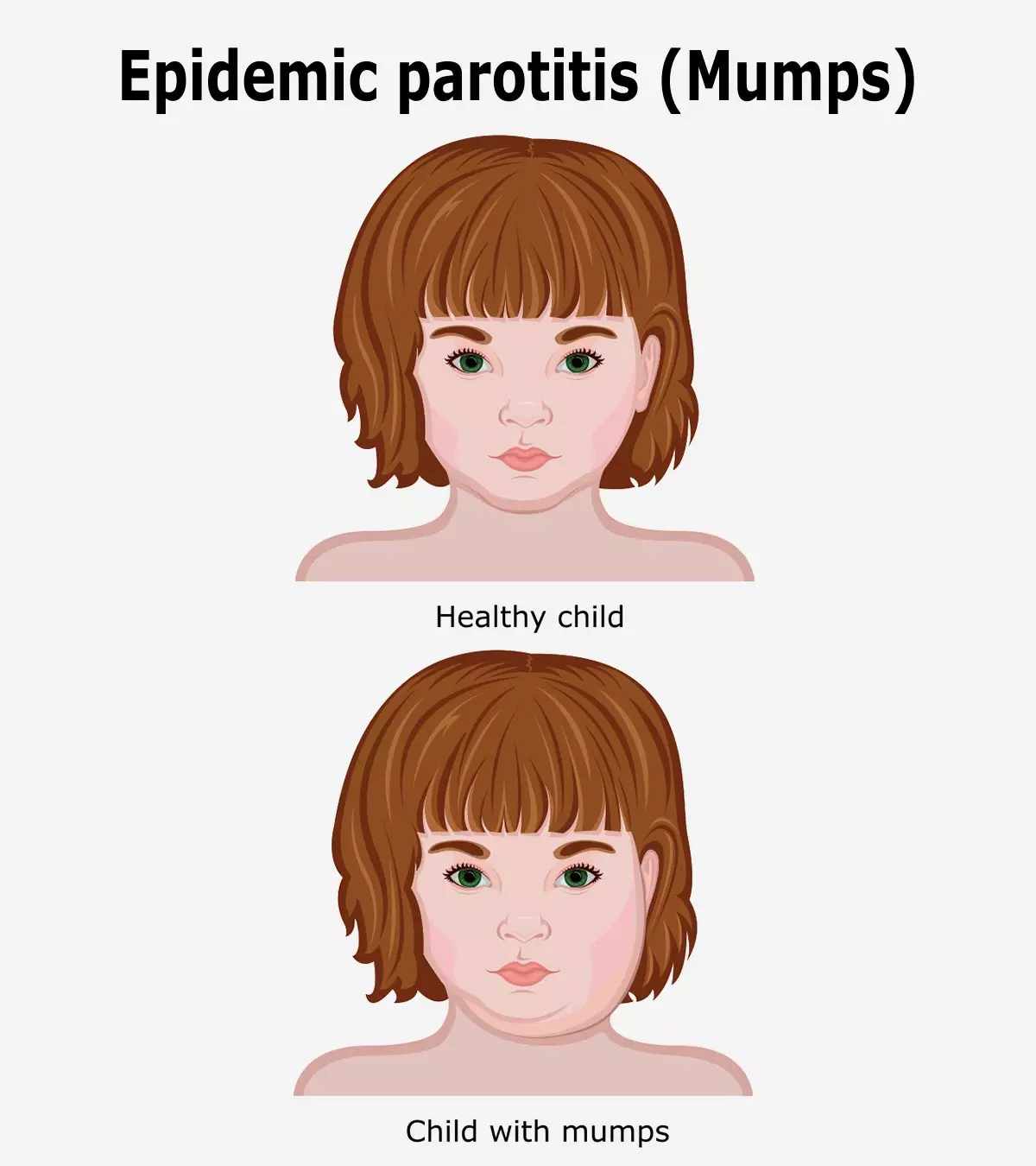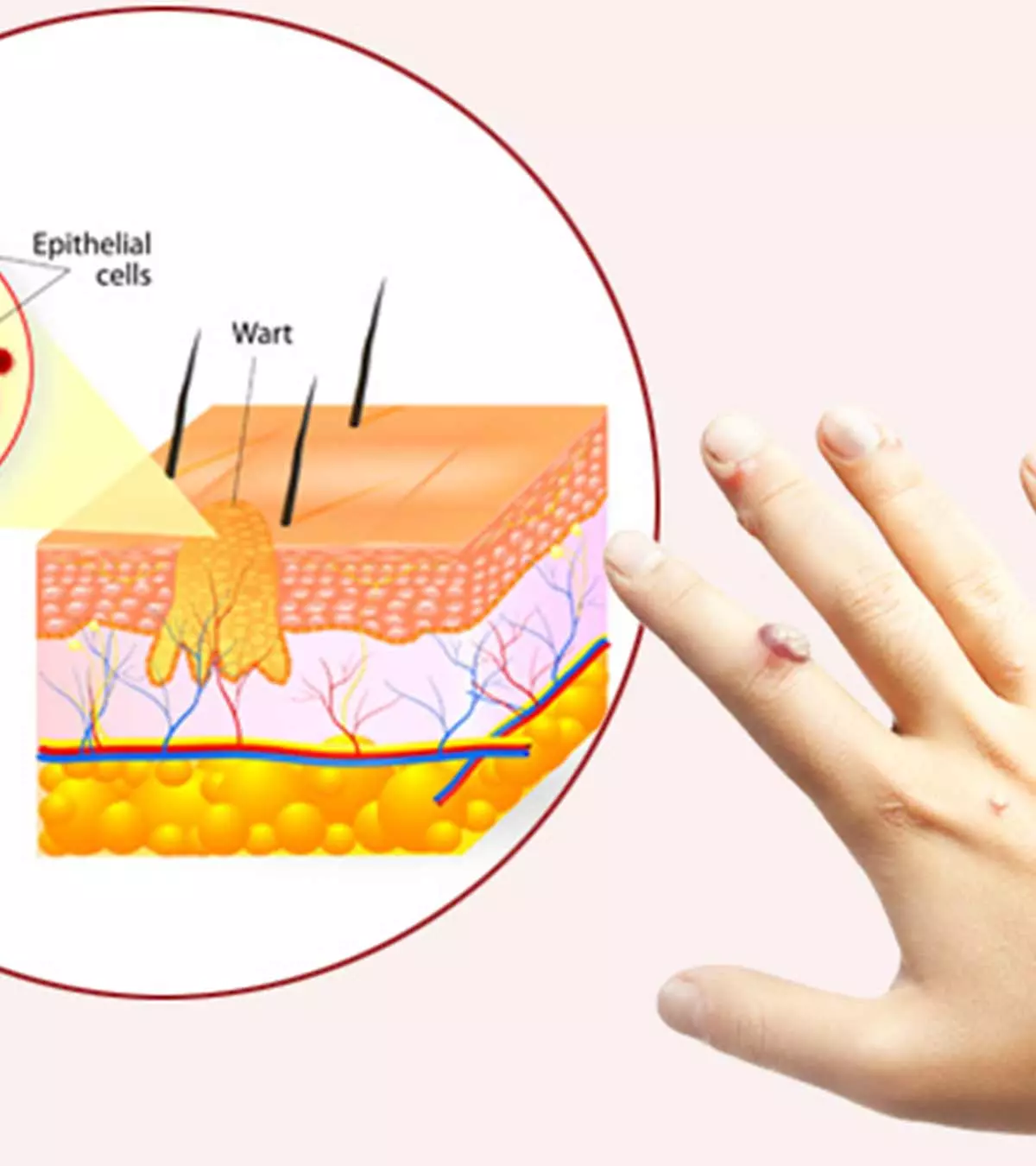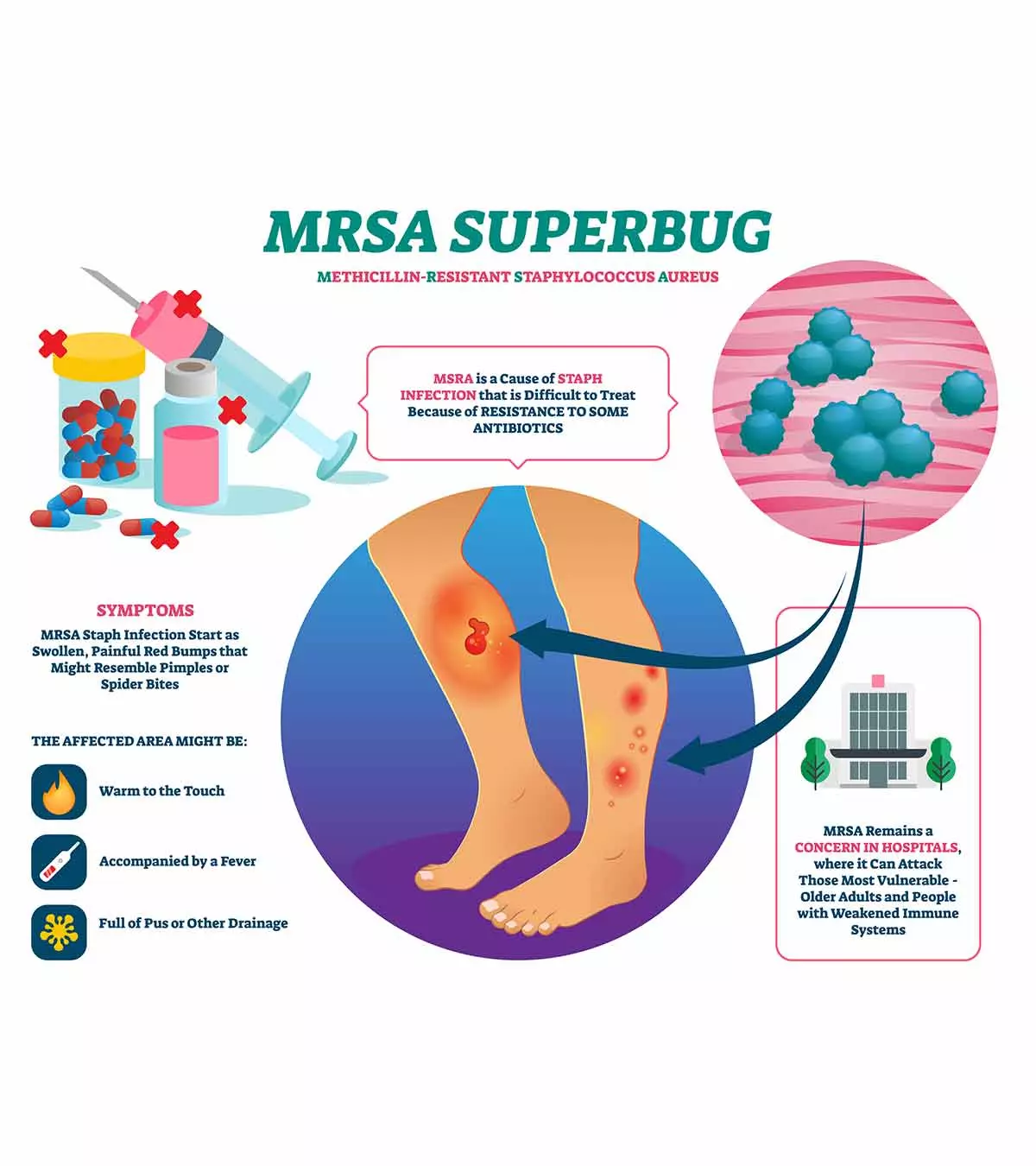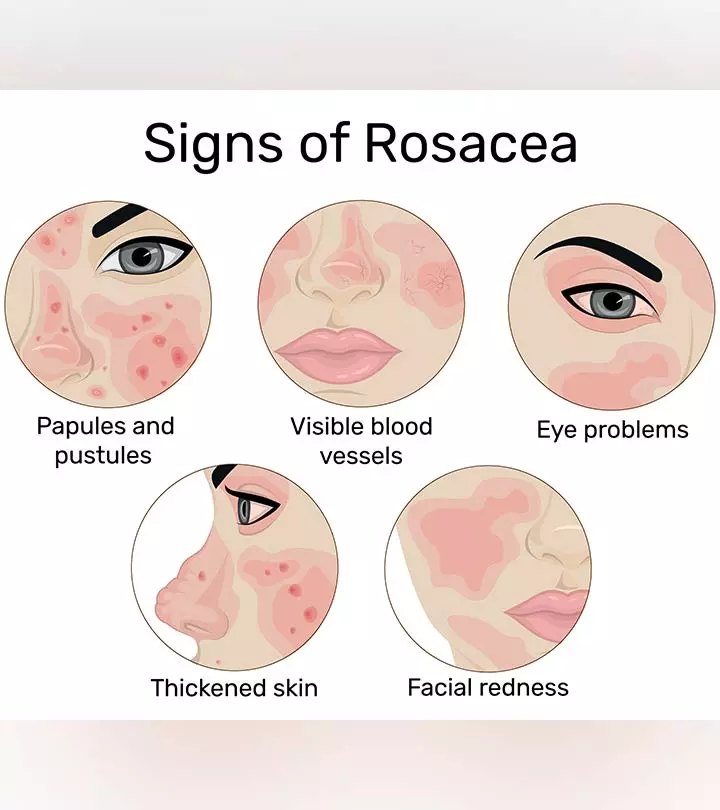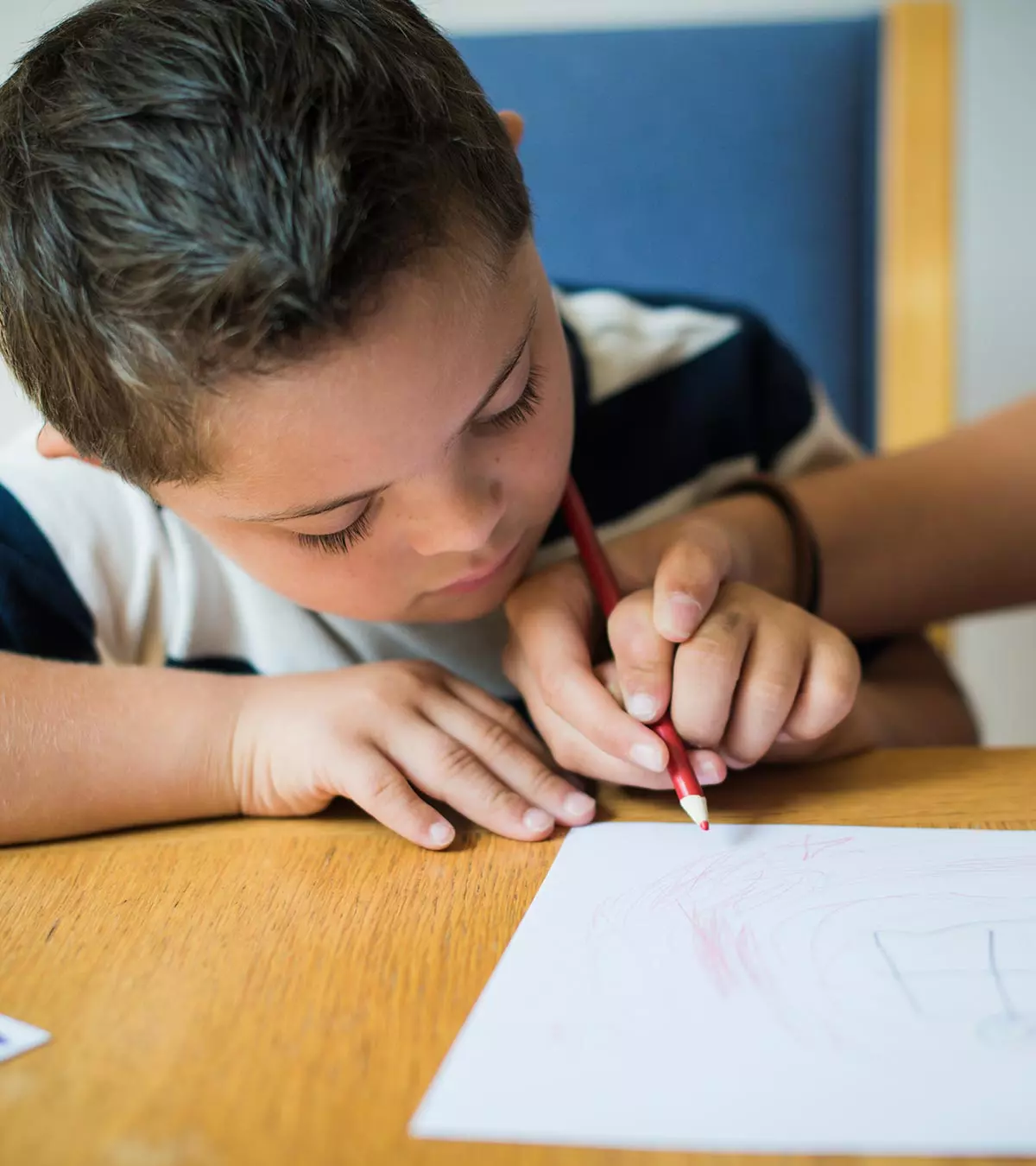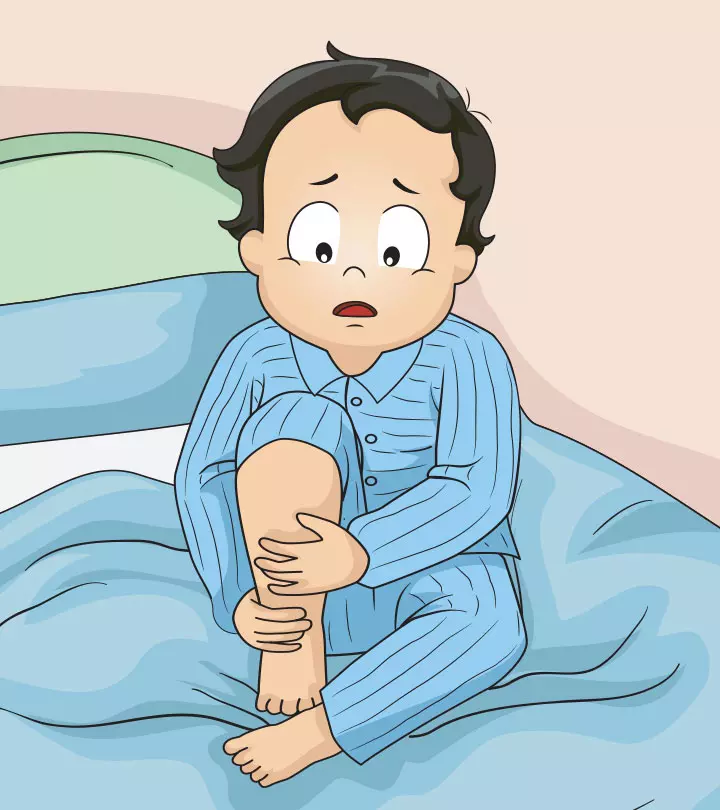
image: Shutterstock

Antihistamines are a class of drugs used to suppress the effects of histamineiChemicals released by the body during an allergic reaction. in tissues to help relieve or prevent allergic symptoms and overproduction of gastric acid. Although antihistamines are available over the counter, it is recommended to seek pediatric consultation before taking them.
It is not recommended to administer antihistamines for kids below two years of age, and a prescription is mandatory for children below six years. The type of antihistamine, dosage, and duration may vary depending on the symptom, severity, age, health conditions, use of other medications, and bodyweight of children.
Read this post to know about the age limits, safety tips, medical uses, and side effects of antihistamines in children.
Key Pointers
- Over-the-counter antihistamines can be given to children above two years
- Apart from allergies and pruritis, these medicines are also prescribed for hay fever, colds, insect stings, and bites.
- While administering the drug, ensure you read the labels carefully, do not overdose and follow the correct prescription timings.
- Antihistamines may also induce side effects in children, such as reduced coordination, dry mouth, headache, and drowsiness.
When Can You Give Antihistamines To Children?
Over-the-counter antihistamines can be given to children older than two years. Antihistamines are not recommended for children younger than two years and are not given to relieve cough and cold symptoms in children younger than six years (1). It is also recommended to seek a prescription for children younger than 12 years of age.
You should always ensure an OTC medication is safe for your child’s age group. Thus, always consult a pediatrician for the right prescription based on your child’s symptoms, body weight, and age.
 Did you know?
Did you know?Medical Uses Of Antihistamines
Antihistamines are also prescribed for several other medical conditions besides allergies, pruritus, and anaphylactic shockiAn extreme reaction to an allergen causing breathing difficulties and loss of consciousness, prompting immediate medical attention. .
H-1 blockers (check the “types” section for more information) are usually prescribed for the following conditions (2):
- Hay fever or allergic rhinitisiNasal inflammation caused in response to an allergen, also characterized by sneezing, sore throat, and congestion.
- HivesiA skin condition characterized by itchy rashes and bumps often triggered by allergic foods or medications. and other skin rashes
- Cold, sneezing, nasal congestion, and runny nose
- Food allergies
- Asthma
- Allergic conjunctivitis
- Insects stings and bites

Image: IStock
- Hypersensitivity to drugs
H-1 blockers are also preferred for treating the following conditions.
- Motion sickness
- Anxiety
- Insomnia
H-2 blockers help reduce stomach acid production.
Therefore, they are prescribed for the following conditions.
- GERD (Gastroesophageal reflux disease)
- Heartburn
- Zollinger-Ellison syndromeiA rare condition characterized by excessive production of stomach acid, causing tumors to form in the pancreas and intestine.
- Gastric and duodenal ulcersiA condition where sores develop on the first part of the small intestine, called the duodenum.
 Quick fact
Quick factSafety Measures To Follow While Giving Antihistamines
Although antihistamines are available over-the-counter, it is recommended to consult a pediatrician if your child has persistent allergic symptoms. The doctor may prescribe more suitable antihistamines in appropriate doses.
The following tips may help you avoid unpleasant events associated with antihistamines (3).
1. Read the labels carefully: Ensure the product is safe for your child’s age. Although a product may be marked for children, it does not always mean that it is safe for all ages and situations. Learn about the dose recommendations according to the child’s age and body weight.
2. Do not give them to babies and toddlers: Do not give antihistamine to children younger than two years. OTC antihistamines are known to cause death in infants and toddlers. Thus, always follow a pediatric prescription to treat younger children.
3. Do not overdose: Do not give more than the recommended dose to your child. You may keep the antihistamine doses within the permitted daily limits to avoid other side effects. Even though these medications are available OTC they can be very dangerous in high doses. Luckily most of these cases only require supportive care.
4. Avoid double dosing: Read the contents of cough and cold products if your child is already taking antihistamines. Some cough and cold remedies contain antihistamines, and this may result in overdosing.
5. Keep them out of your child’s reach: You may keep antihistamines out of your child’s reach to avoid accidental consumption.

Image: Shutterstock
6. Keep an eye on your child’s activities: Do not let the child do activities requiring alertness since some antihistamines can cause drowsiness.
7. Avoid overuse of topical creams and ointments: Antihistamine creams and ointments should be applied on the skin as directed. The skin absorbs these, and overdosing can be toxic to the child.
8. Follow the correct prescription timings: Antihistamines should be given to the child as per the prescription since some medications may have their effects for a short time, and others may act for 12 to 24 hours. You may follow the timings mentioned in the prescription since some are given before the symptoms occur, such as before the season for seasonal allergies.
Children taking anticonvulsants for epilepsy should not be given antihistamines since this may cause drug interactions. Exercise caution when taking other drugs and medical conditions as well. You may seek a doctor’s advice if your child has liver or kidney problems or other chronic conditions.
Types Of Antihistamines
Antihistamines are available in various forms, including tablets, syrups, capsules, liquids, lotions, gels, creams, nasal sprays, and eye drops. Doctors may prescribe any of these depending on the illness.
Antihistamines can be divided into two main groups based on their effects. These include (2)
- Drowsy antihistamines that cause sleepiness or drowsiness, such as promethazine, hydroxyzine, and chlorpheniramine (Piriton).
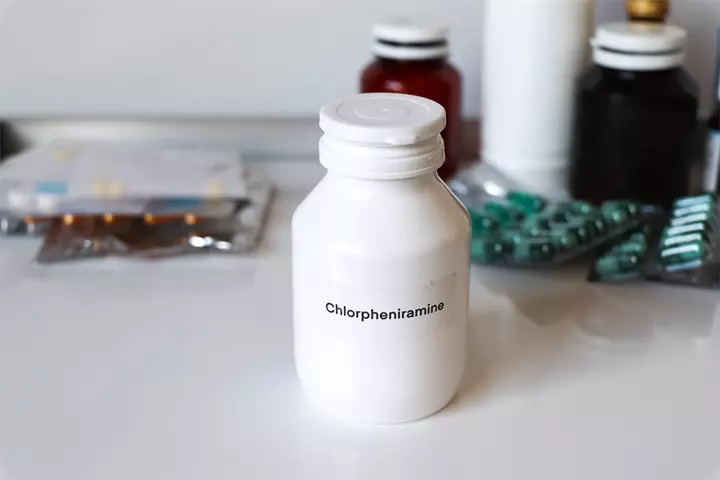
Image: Shutterstock
- Non-drowsy antihistamines that are less likely to cause drowsiness or sleepiness, such as loratadine, fexofenadine, and cetirizine.
Based on the pharmacological action, antihistamines can be divided into two subtypes. These include (2)
- H-1 blockers or H-1 receptor antagonists
These are antihistamines used to manage allergy symptoms. They are further classified into first-generation antihistamines (approved from the 1930s) and second-generation antihistamines (1980s) based on when the US FDA approved them for use.
Examples of first-generation H-1 antihistamines are (2)
- Chlor-Trimeton (chlorpheniramine)
- Benadryl (diphenhydramine)
- Children’s Dimetapp Cold (brompheniramine)
- Vistaril (hydroxyzine)
- Dayhist (clemastine)
- Nolahist (phenindamine)
- Periactin (cyproheptadine)
- Dramamine (dimenhydrinate)
- Vicks NyQuil and other common cold and flu reliefs (doxylamine)
Second generation H-1 antihistamines may include (2):
- Zyrtec (cetirizine)
- Astelin (azelastine)
- Clarinex (desloratadine)
- Claritin (loratadine)
- Allegra (fexofenadine)
These medications are available on prescription and over the counter. You may seek pediatric consultation to know the proper dosage and duration of treatment.
- H-2 blockers or H-2 receptor antagonists
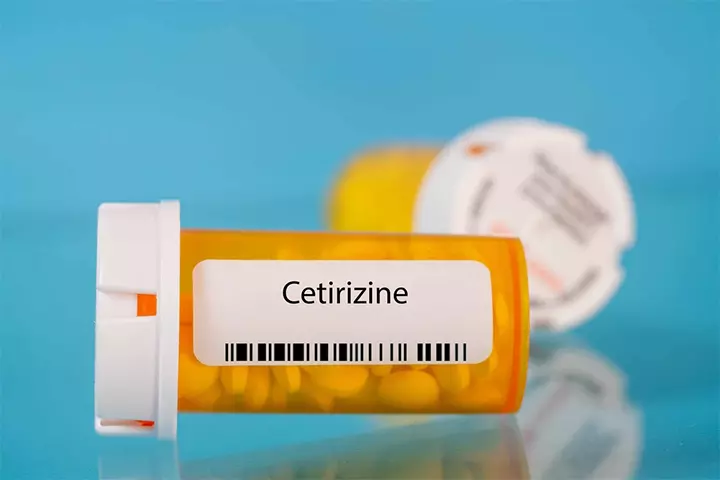
Image: Shutterstock
These are used to treat gastrointestinal problems such as acid reflux in children or GERD, vomiting, nausea, peptic ulcers, and gastritis.
A few examples of H-2 blockers are
- Axid (nizatidine)
- Pepcid (Famotidine)
- Tagamet HB (cimetidine)
- Zantac (ranitidine)
First-generation antihistamines block histamine receptors all over the body, including the brain and spinal cord, and cause drowsiness. In contrast, second-generation antihistamines do not cross the blood-brain barriers and do not usually cause drowsiness. Second-generation antihistamines are considered to be safer as they interact with fewer drugs and do not cause drowsiness.
Side Effects Of Antihistamines
Antihistamines may cause side effects in some children, and the side effects may vary depending on the type of antihistamine. The common side effects of drowsy antihistamines besides drowsiness include (4)
- Reduced coordination and responses (reactions)
- blurred vision
- Dry mouth
- Oliguria (reduced peeing)
The following side effects are often seen in non-drowsy antihistamines.
- Headache
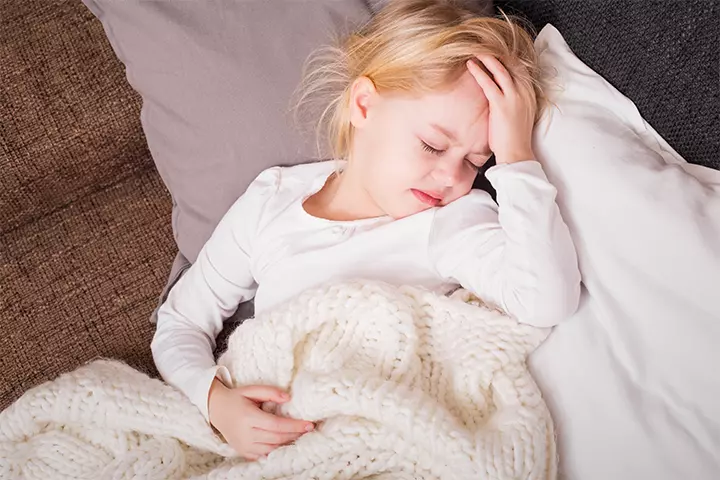
Image: IStock
- Dry mouth
- Feeling sick
- Feeling drowsy (rare)
Do not use machinery or drive after taking antihistamines since it can affect a person’s alertness and responses. If your child has side effects after taking antihistamines, you may inform their healthcare provider.
Frequently Asked Questions
1. Which antihistamine is better for kids?
Newer generation antihistamines such as cetirizine (Zyrtec) and loratadine (Claratyne) cause less drowsiness and may be more suitable for children. These medications may be given to children above six months (the older generation, sedative antihistamines are not suitable for children below two years) (5).
2. How long can you give a child antihistamines?
Antihistamines are usually not meant for long-term use in children. Consult a doctor if your kid’s symptoms persist beyond a few days (5).
3. Is it better to take antihistamines at night or in the morning?
Over-the-counter (OTC) antihistamines, particularly those of the first generation, cause drowsiness. Hence it is advisable to give the dose in the evening (6).
4. Do antihistamines stop itchy skin?
Yes, antihistamines can provide symptomatic relief from itching skin (7).
5. What is a natural antihistamine for children?
There are a number of natural antihistamines available, but you should have a word with your doctor before giving any to your child. Some natural antihistamines are stinging nettle that can be used on as needed, and quercetin (found in onions, broccoli, apples, and berries) can help prevent allergies in children (8) (9). Butterbur in supplement form can help in seasonal allergic rhinitis but ensure that it is free of cancer-causing pyrrolizidine alkaloids (10). Black seed oil or Nigella sativa, when applied topically, has also been found to be effective against allergic rhinitis (11).
Antihistamines for kids may be prescribed for health conditions such as allergies, colds, skin rashes, etc. These antihistamines are available OTC. Antihistamines only help relieve the symptoms but do not treat the condition. However, it is better to consult a doctor before using any of these medicines for your child; especially if they have persistent allergy symptoms, wheezing, gastrointestinal ulcers, or acid reflux, you should visit a pediatrician. Long-term use of antihistamines is not recommended for children.
Infographic: More About H2 Antihistamines
The biologically active substance histamine shows its action mainly by interacting with the H1 and H2 types of histamine receptors. Although other types of histamine receptors are present, these two have more clinical importance. The H2 receptors are present in the stomach cells and participate in gastric acid secretion. The infographic below explains more about how H2 antihistamines block the H2 receptors.
Some thing wrong with infographic shortcode. please verify shortcode syntax
Illustration: Antihistamine For Children: Uses Safety And Side Effects

Image: Stable Diffusion/MomJunction Design Team
References
1. Children and Sedating Antihistamines; MEDSAFE; New Zealand Medicines and Medical Devices Safety Authority
2. Antihistamines; Cleveland Clinic
3. Take Care With Antihistamine And Kids; Healthgrades
4. Antihistamines; NHS
5. Medicines for children: a guide; Raising Children Network
6. Allergy Medicine for Children; American Academy of Pediatrics
7. Antihistamines for allergies; Medline Plus
8. Natural supplements — and other remedies — for seasonal allergies; Novant Health
9. Quercetin and Its Anti-Allergic Immune Response; Pub Med
10. Herbal medicines for the treatment of allergic rhinitis: a systematic review; Pub Med
11. Evaluation of topical black seed oil in the treatment of allergic rhinitis; Pub Med
Community Experiences
Join the conversation and become a part of our nurturing community! Share your stories, experiences, and insights to connect with fellow parents.
Read full bio of Dr. Wayne Hough
Read full bio of Dr Bisny T. Joseph
Read full bio of Dr. Ritika Shah
Read full bio of Vidya Tadapatri







